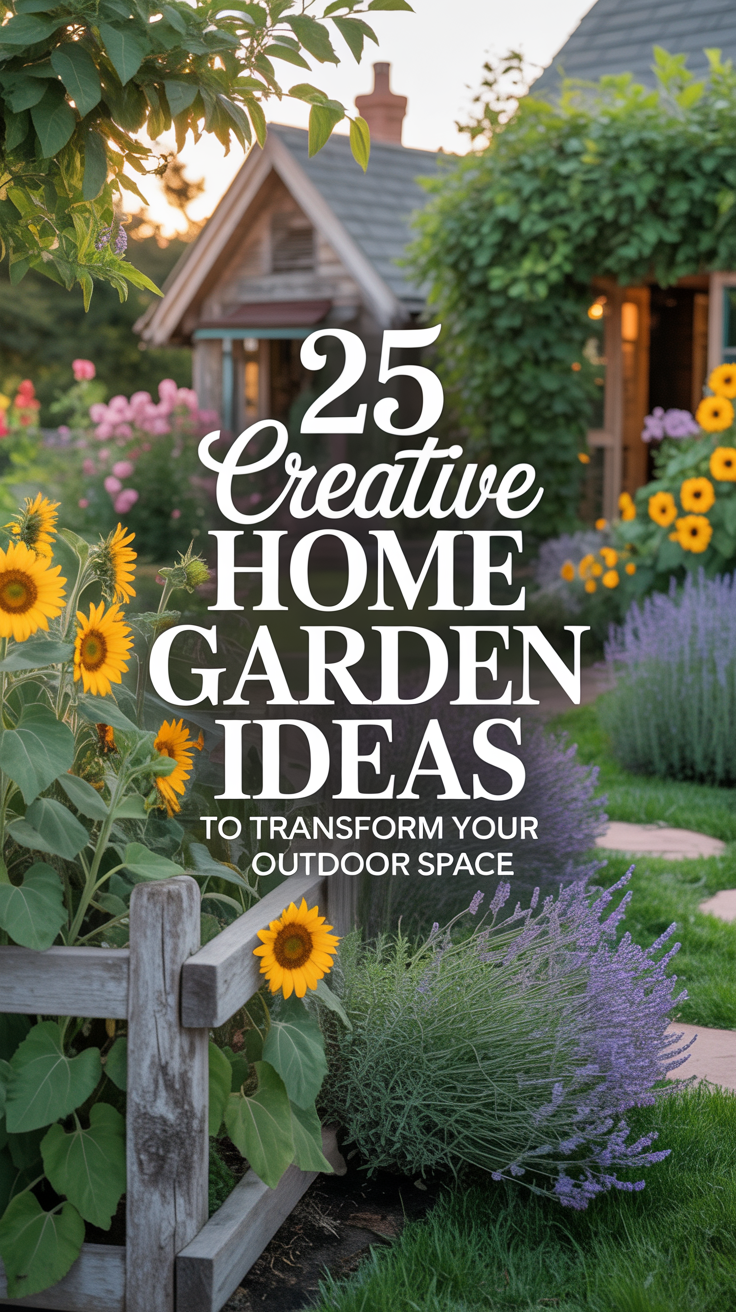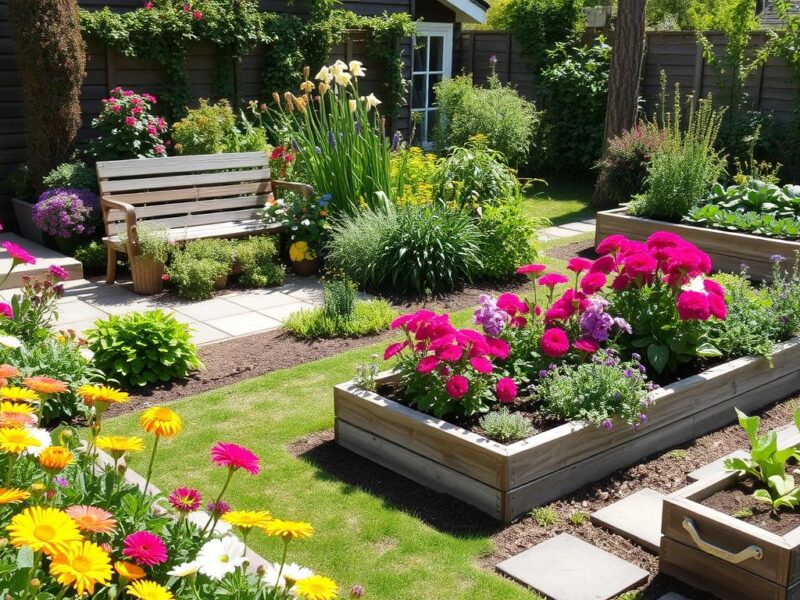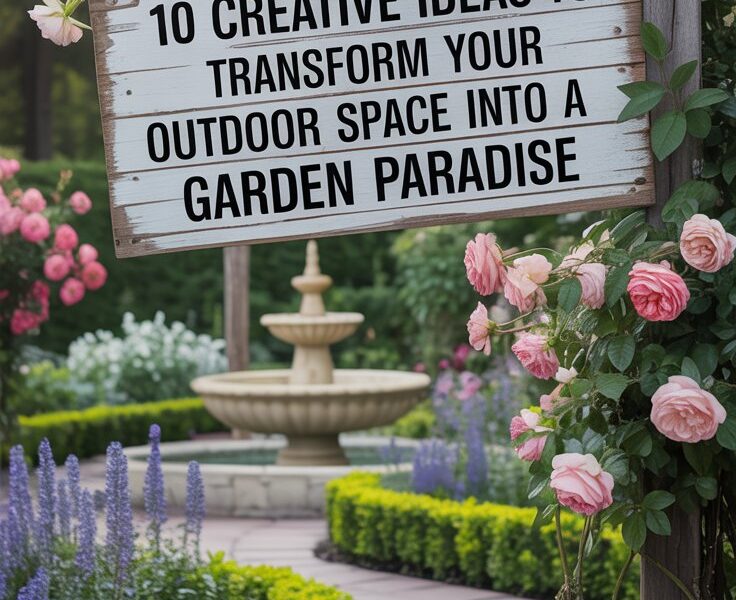Your home garden can be a delightful retreat, showcasing your personality and creativity. From cozy vegetable patches to vibrant flower beds, there are countless ideas to spruce up your outdoor space. Let your imagination run wild as you explore exciting ways to transform your garden into a personal paradise, perfect for relaxation or fun gatherings.
Composting Corner for Sustainable Gardening
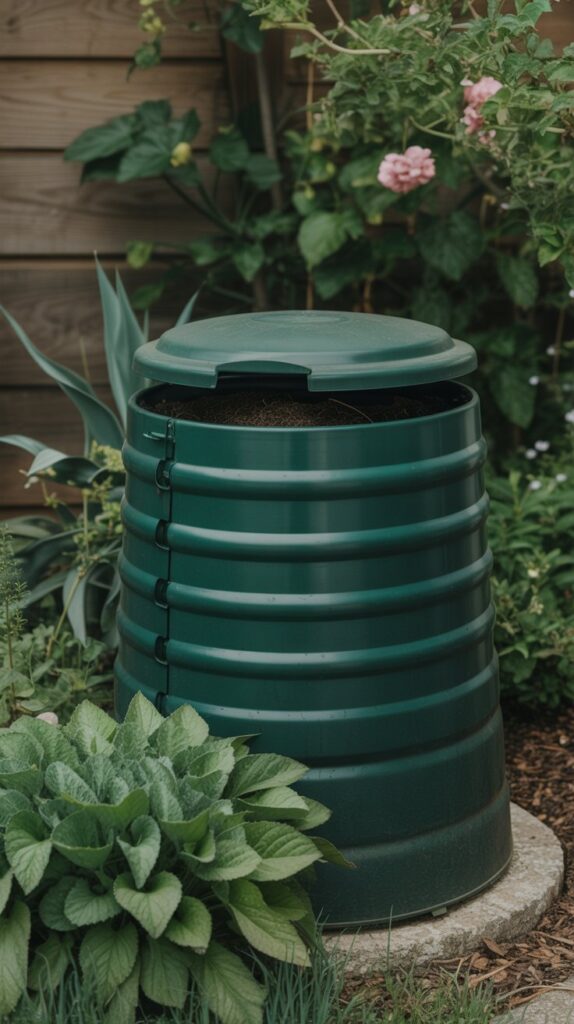
Creating a composting corner in your garden is a fantastic way to recycle kitchen scraps and yard waste. It not only reduces landfill waste but also enriches your soil with nutrients. In the image, you can see a compost bin surrounded by lush greenery. This setup is perfect for those looking to embrace sustainable gardening practices.
The compost bin is clearly labeled, making it easy to identify. It’s nestled among vibrant plants, showing how composting can seamlessly integrate into your garden space. You can toss in vegetable peels, coffee grounds, and even yard clippings to create a rich compost mix.
Having a dedicated composting area encourages you to be mindful of waste. It’s a simple step towards a more eco-friendly lifestyle. Plus, the end product is a wonderful addition to your garden, promoting healthy plant growth.
Vertical Gardening for Small Spaces
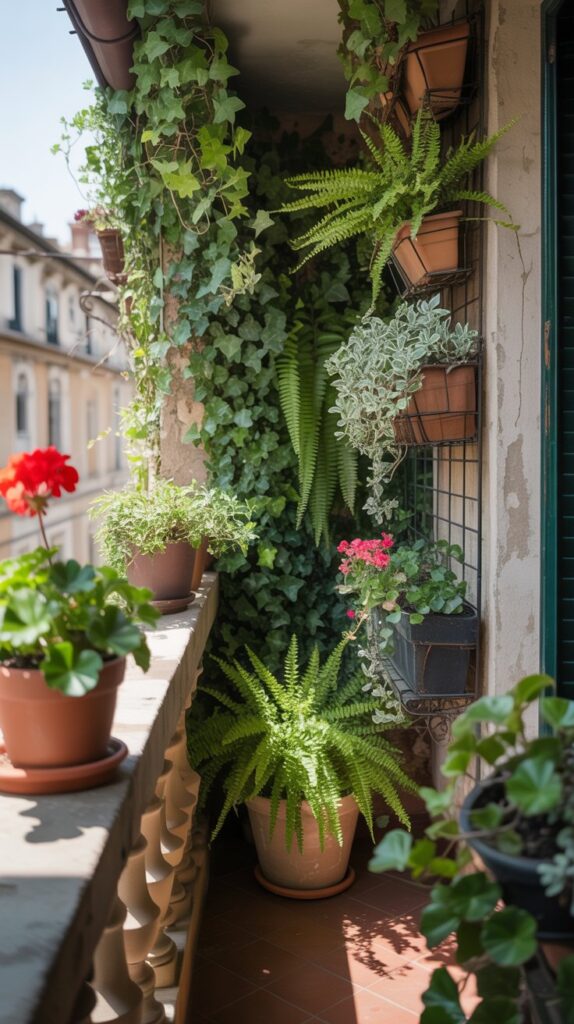
Vertical gardening is a fantastic way to make the most of limited space. The image shows a balcony filled with lush greenery, showcasing how you can create a vibrant garden even in tight areas. The plants are arranged vertically, climbing up a wall and spilling over in pots, which adds depth and character.
Using vertical space allows you to grow a variety of plants without taking up too much floor area. The cascading vines and leafy plants create a cozy atmosphere, making your small space feel more inviting. You can mix different types of plants, from trailing vines to sturdy greens, to achieve a beautiful display.
Consider using wall-mounted planters or trellises to support your plants. This not only saves space but also adds an artistic touch to your home. With a little creativity, you can transform any small area into a green sanctuary.
Garden Pathways with Natural Stone
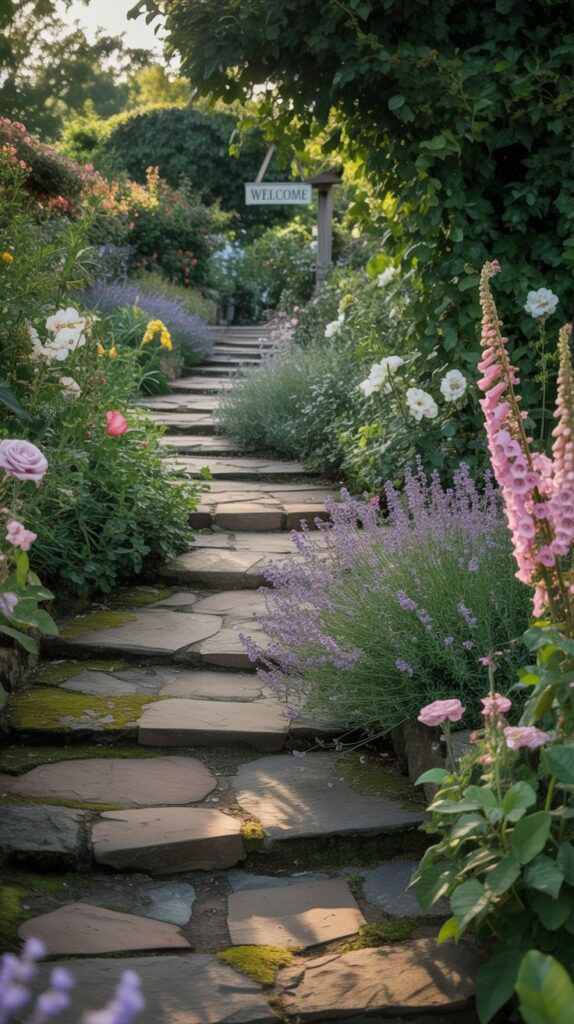
Creating a charming pathway in your garden can really enhance its beauty. Using natural stone for your garden path adds a rustic touch that blends seamlessly with the surrounding greenery.
The image shows a lovely winding path made of flat stones, bordered by vibrant flowers and lush plants. This design invites you to stroll through the garden, enjoying the sights and scents of nature.
Natural stone is not only durable but also offers a variety of colors and textures. You can choose stones that match your garden’s theme or create a contrast for a more dynamic look. The gentle curves of the path guide you through the garden, making each step feel like a new discovery.
To maintain the path, consider filling the gaps between the stones with moss or small pebbles. This not only keeps the stones in place but also adds to the natural feel of the walkway. A well-designed path can lead to a cozy seating area or a beautiful flower bed, making your garden a delightful retreat.
Container Gardening for Mobility
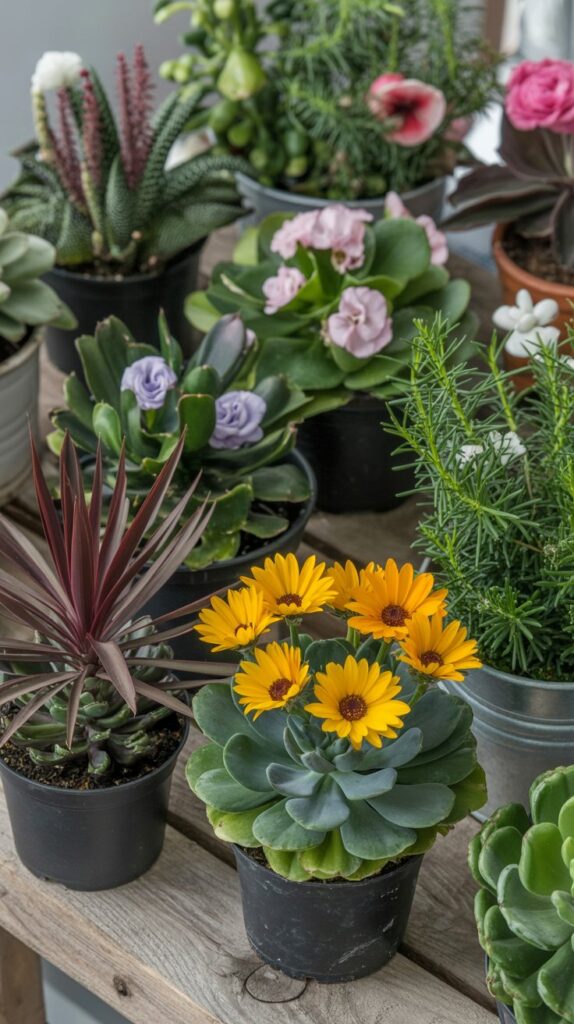
Container gardening is a fantastic option for those who want to enjoy gardening without the need for a large yard. It allows you to grow plants in pots, making it easy to move them around as needed. This flexibility is especially helpful for people with mobility challenges.
The image shows a vibrant collection of potted plants, featuring colorful flowers and lush greenery. Each pot is filled with rich soil, ready to nurture the plants. This setup not only brightens up any space but also makes gardening accessible for everyone.
Using containers means you can create a beautiful garden on a balcony, patio, or even indoors. You can choose pots that fit your style and space. Plus, it’s easier to manage watering and care for your plants when they’re in containers.
Consider using lightweight pots if you need to move them frequently. You can also mix different plants in one pot for a more dynamic look. Herbs, flowers, and even small vegetables can thrive together, giving you a mini garden that’s both functional and pretty.
Raised Bed Vegetable Gardens
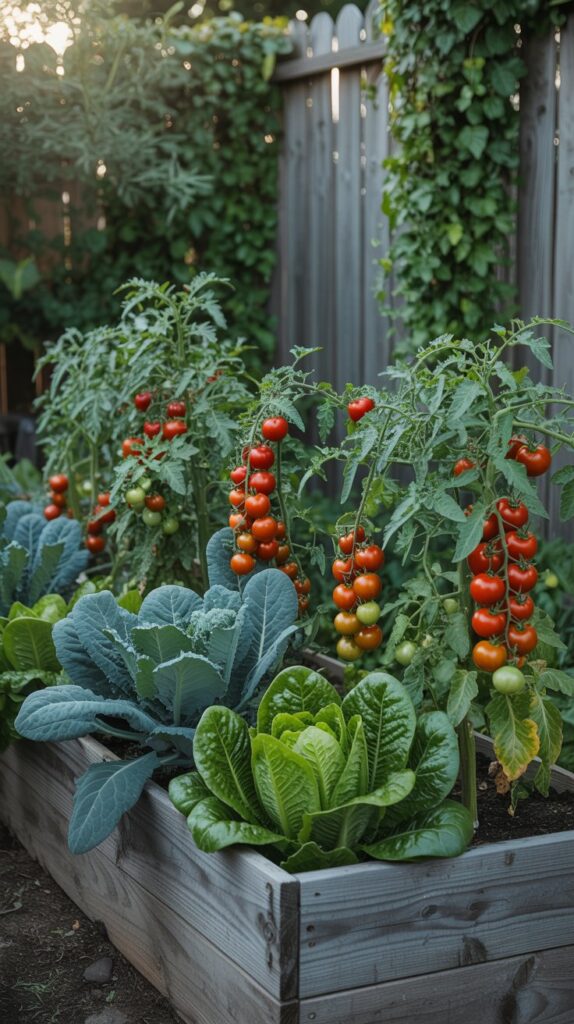
Raised bed vegetable gardens are a fantastic way to grow your own food. They offer a neat and organized space for planting a variety of vegetables. In the image, you can see vibrant greens, bright tomatoes, and other colorful veggies all thriving together.
These beds are usually elevated, which makes it easier to tend to your plants. You can see how the different layers of vegetables create a beautiful display. The variety of colors and textures not only looks great but also provides a diverse harvest.
Raised beds can help with drainage and soil quality. They warm up faster in the spring, allowing for an earlier planting season. Plus, they can be built to any size, making them perfect for any garden space.
Whether you’re growing tomatoes, lettuce, or carrots, raised beds can make gardening more enjoyable. They can also be a great way to involve kids in gardening, teaching them about where food comes from.
Pollinator-Friendly Flower Beds
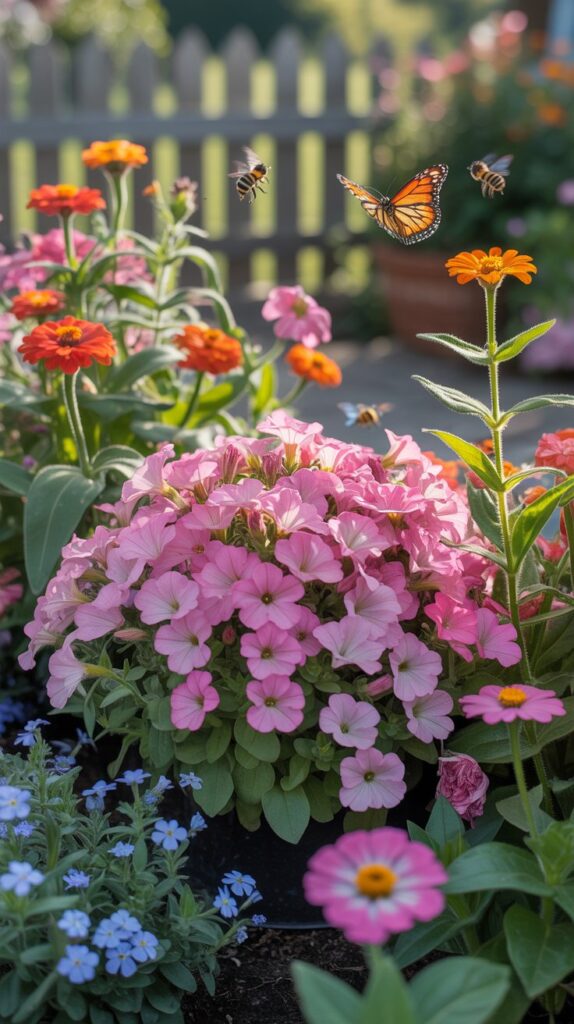
Creating a pollinator-friendly flower bed can be a delightful addition to your home garden. Imagine a vibrant display of colors with flowers in shades of pink, orange, and blue. These flowers not only beautify your space but also attract essential pollinators like bees and butterflies.
In the image, you can see a lively mix of flowers, each buzzing with activity. The bees are busy collecting nectar, while butterflies flutter around, adding to the charm. This lively scene highlights the importance of choosing the right plants for your garden.
When selecting flowers, opt for native species that thrive in your area. They are often more appealing to local pollinators. Consider planting a variety of blooms that flower at different times throughout the season. This ensures that there is always something in bloom, providing a steady food source for pollinators.
Don’t forget to include some taller plants in the back and shorter ones in the front for a layered look. This not only creates visual interest but also makes it easier for pollinators to navigate your garden. With a little planning, your flower beds can become a buzzing hub of activity!
Herb Spiral for Culinary Enthusiasts
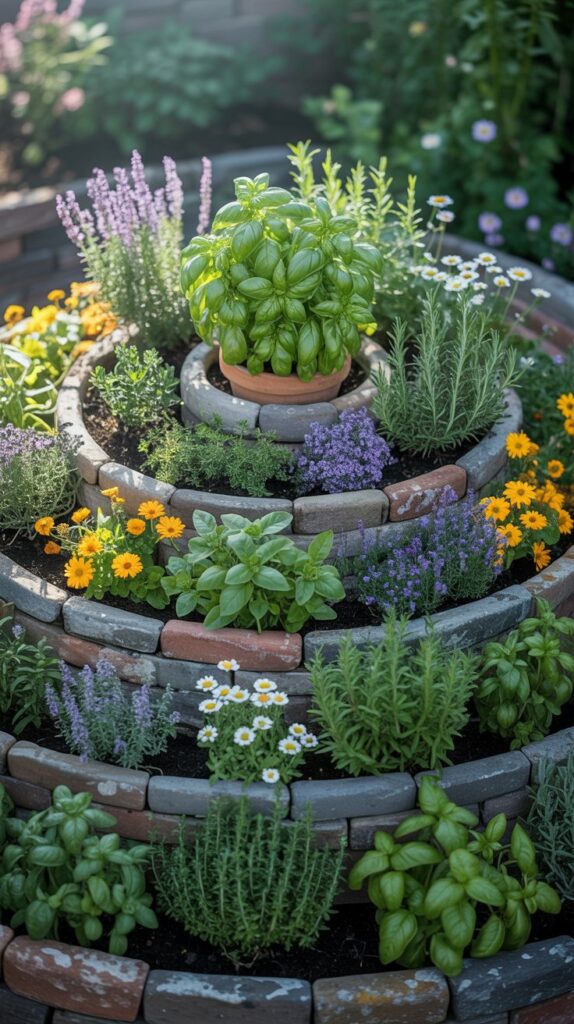
A herb spiral is a fantastic way to maximize space in your garden while growing a variety of herbs. This unique structure not only looks great but also offers different microclimates for your plants. The spiral design allows for better drainage and sunlight exposure, making it easier to cultivate herbs like basil, mint, and thyme.
In the image, you can see a beautifully arranged herb spiral filled with lush greenery. The circular shape creates a visually appealing focal point in the garden. Each section of the spiral can host different herbs, allowing you to experiment with flavors in your cooking.
Building a herb spiral is simple. Start by selecting a sunny spot in your yard. Gather materials like stones or bricks to create the spiral shape. Fill it with quality soil and plant your favorite herbs. As they grow, you’ll enjoy fresh ingredients right at your fingertips, enhancing your culinary creations.
Shade Gardens with Ferns and Hostas
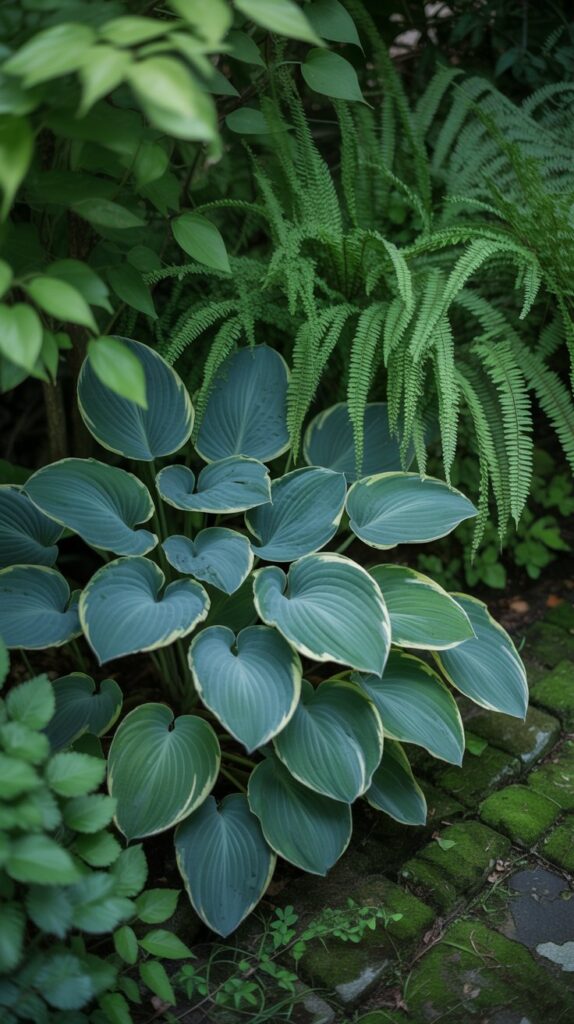
Creating a shade garden can be a delightful way to bring life to darker areas of your yard. The image shows a lush arrangement of ferns and hostas, showcasing their vibrant greens and unique textures. These plants thrive in low-light conditions, making them perfect for shaded spots.
Ferns are known for their feathery leaves, which can add a soft, flowing element to your garden. They come in various sizes and shapes, allowing for creative combinations. Hostas, on the other hand, offer a range of leaf colors and patterns, from deep greens to striking variegated varieties. Together, they create a stunning visual contrast.
When planning your shade garden, consider the layout. Grouping plants in clusters can create a more natural look. Mixing different types of ferns and hostas can also enhance the garden’s appeal. Don’t forget to add some mulch to retain moisture and suppress weeds.
This combination of ferns and hostas not only beautifies your space but also provides a habitat for local wildlife. Birds and beneficial insects are often attracted to these plants, adding to the garden’s ecosystem. Enjoy the tranquility that a shade garden can bring!
Garden Lighting for Evening Ambiance
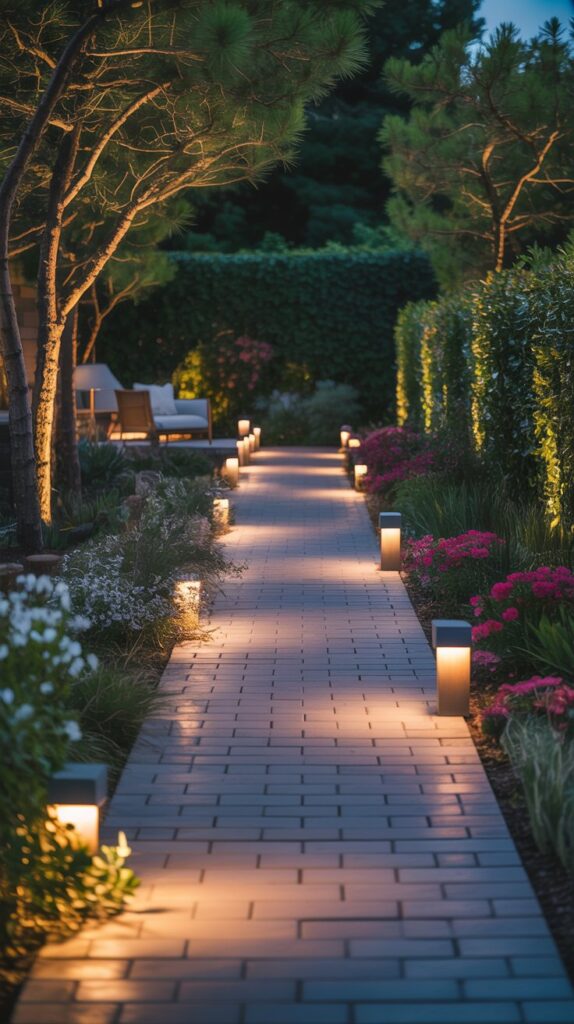
Creating a cozy atmosphere in your garden during the evening can be a game changer. The right lighting can transform your outdoor space into a welcoming retreat. Imagine walking along a softly lit path, surrounded by gentle glows that highlight the beauty of your plants and flowers.
The image shows a lovely garden path illuminated by warm lights. These lights not only guide your way but also add a touch of magic to the surroundings. The trees and shrubs are subtly lit, creating interesting shadows and depth. This kind of lighting makes the garden feel alive, even at night.
Using different types of lights can enhance the mood. For instance, pathway lights can help you navigate while accent lights can draw attention to specific plants or features. String lights can add a festive feel, perfect for gatherings or quiet evenings. Consider mixing these options to create layers of light that make your garden shine.
Garden Furniture for Relaxation
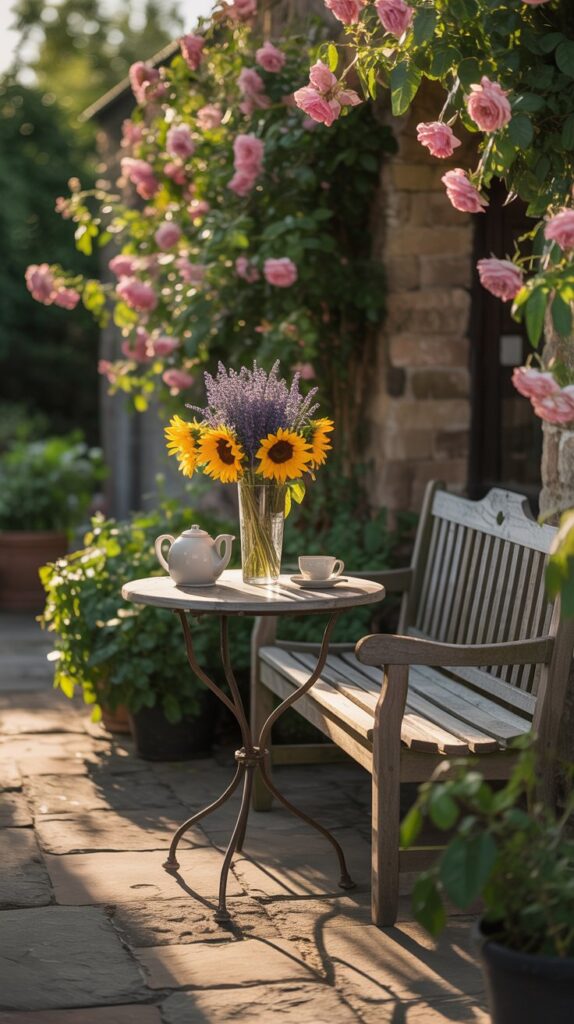
Your garden can be a perfect spot for relaxation, and the right furniture makes all the difference. Imagine a cozy wooden bench with soft cushions, inviting you to sit back and enjoy the beauty around you. In this image, we see a lovely setup surrounded by vibrant flowers and lush greenery.
The bench, paired with a small table, creates a welcoming space for sipping tea or reading a book. The colorful blooms add a cheerful touch, making the area feel alive and inviting. This setup is not just about aesthetics; it’s about creating a personal retreat right in your backyard.
Consider adding some potted plants around the seating area. They not only enhance the beauty but also provide a sense of tranquility. A well-placed bench can turn any corner of your garden into a peaceful escape.
DIY Garden Trellises for Climbing Plants
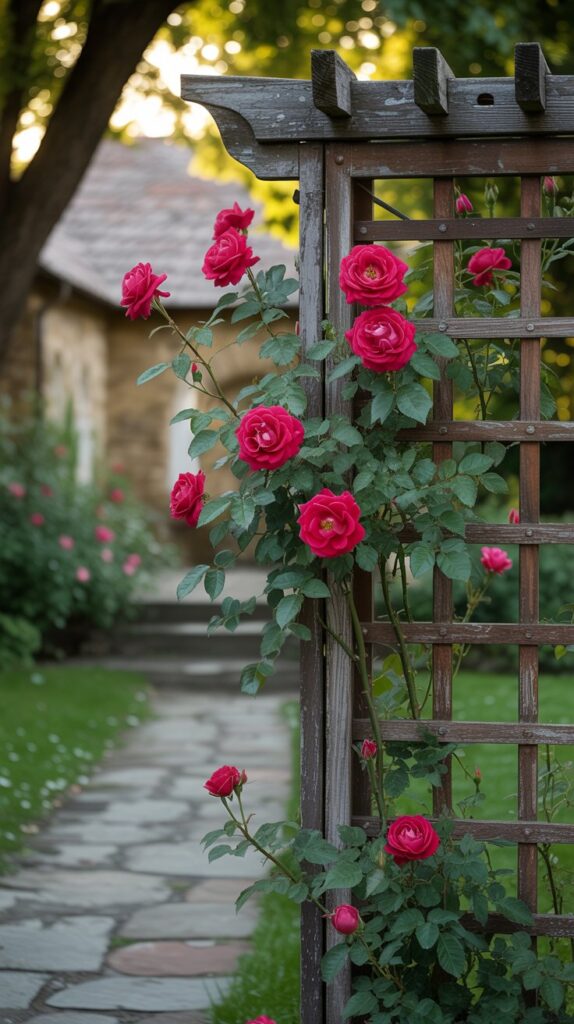
Creating a DIY garden trellis can be a fun and rewarding project. The image shows a beautiful wooden trellis covered in lush green climbing plants. This structure not only supports the plants but also adds charm to the garden.
Using natural materials like wood gives a rustic feel. The trellis in the image has sturdy posts and a simple design, making it easy to replicate. You can customize the size to fit your garden space.
Climbing plants, such as beans or peas, thrive on trellises. They grow upward, saving space and providing a lovely green backdrop. Plus, they can improve air circulation around the plants, which is beneficial for their growth.
Building a trellis can be as simple as using wooden stakes and wire or going for a more elaborate design with lattice panels. Whatever you choose, it’s a great way to enhance your garden while supporting your plants.
Wildflower Meadows for Natural Beauty
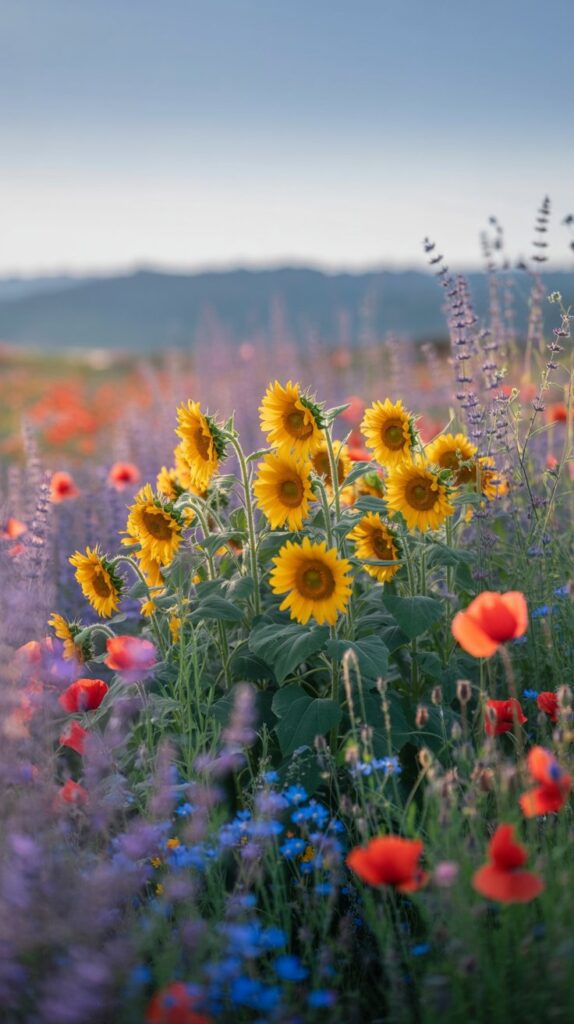
Wildflower meadows bring a splash of color and life to any garden. Imagine stepping into a vibrant sea of flowers, where daisies, poppies, and cornflowers dance in the breeze. This image captures that essence perfectly, showcasing a lively mix of blooms under a bright blue sky.
Creating a wildflower meadow is simple and rewarding. Start by choosing a sunny spot in your yard. Prepare the soil by clearing weeds and loosening it up. Then, scatter a mix of wildflower seeds that suit your local climate. Water them lightly, and soon enough, you’ll see a beautiful array of colors sprouting up.
These meadows not only look stunning, but they also attract butterflies and bees, making your garden a buzzing hub of activity. Plus, they require less maintenance than traditional gardens, allowing you to enjoy nature without too much fuss.
So, if you’re looking for a way to enhance your outdoor space, consider planting a wildflower meadow. It’s a delightful way to celebrate nature’s beauty right at home!
Fruit Trees for Home Orchards

Fruit trees can transform your backyard into a delightful orchard. Imagine stepping outside and picking fresh fruit right from your garden. It’s a simple pleasure that brings joy and flavor to your meals.
The image shows beautiful flowering trees, hinting at the promise of delicious fruit. These trees not only provide shade but also attract pollinators, which are essential for fruit production. Choosing the right varieties can make your garden a vibrant space.
Consider planting apple, peach, or cherry trees. They are popular choices that thrive in many climates. Each tree has its own unique beauty and fruiting season, adding variety to your garden.
With proper care, these trees can yield fruit for years to come. Regular watering, pruning, and pest management will help keep them healthy. Plus, the satisfaction of growing your own fruit is unmatched.
So, if you’re looking to enhance your home garden, think about adding some fruit trees. They are a wonderful way to enjoy nature and enjoy the fruits of your labor!
Edible Landscaping for Aesthetic Appeal
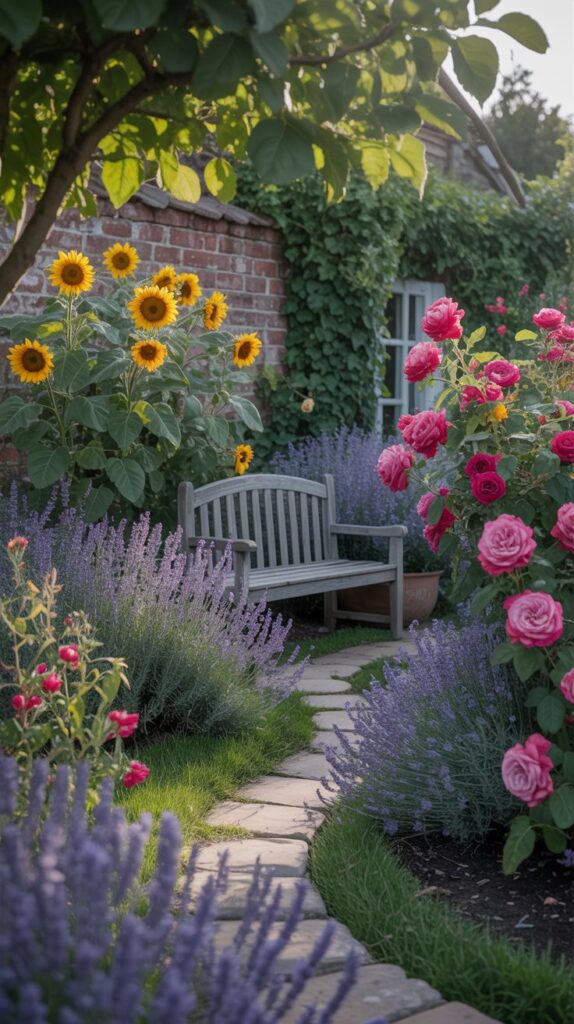
Imagine stepping into a garden that not only looks beautiful but also offers tasty treats. Edible landscaping combines aesthetics with functionality. You can create a stunning space filled with colorful fruits, vegetables, and herbs.
The image shows a vibrant garden path lined with lush plants. The mix of greens, reds, and yellows creates a lively atmosphere. You can easily incorporate edible plants like strawberries, tomatoes, or herbs among the flowers. This way, your garden becomes a feast for the eyes and the palate.
Using edible plants adds texture and color to your landscape. For instance, bright red tomatoes or yellow peppers can stand out beautifully against green foliage. You can even plant herbs like basil or mint, which not only look great but also smell amazing.
Creating an edible landscape is all about balance. You can have ornamental plants alongside your vegetables, making your garden look inviting. Plus, it encourages you to spend more time outdoors, enjoying the beauty and bounty of your hard work.
Water Features for Tranquility
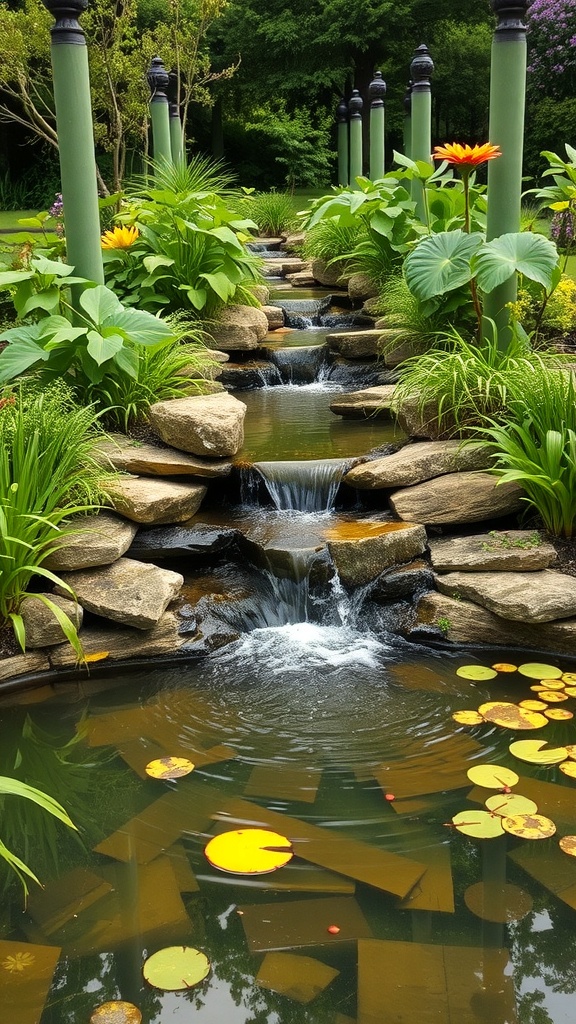
Water features can transform your garden into a peaceful retreat. The image shows a lovely cascading stream flowing over smooth stones, creating a soothing sound that invites relaxation. Surrounding the water are vibrant green plants and colorful flowers, adding life and beauty to the scene.
Adding a water feature like this can be a great way to enhance your outdoor space. The gentle trickle of water not only looks beautiful but also helps to drown out noise from nearby streets or neighbors. Imagine sitting by this stream with a good book or enjoying a cup of tea while listening to the calming sounds of nature.
Consider incorporating elements like lily pads and rocks to create a natural look. You can also add lighting to highlight the water feature at night, making your garden a magical place after sunset. Whether you have a large yard or a small patio, a water feature can bring a touch of tranquility to your home garden.
Succulent Arrangements for Minimalist Spaces
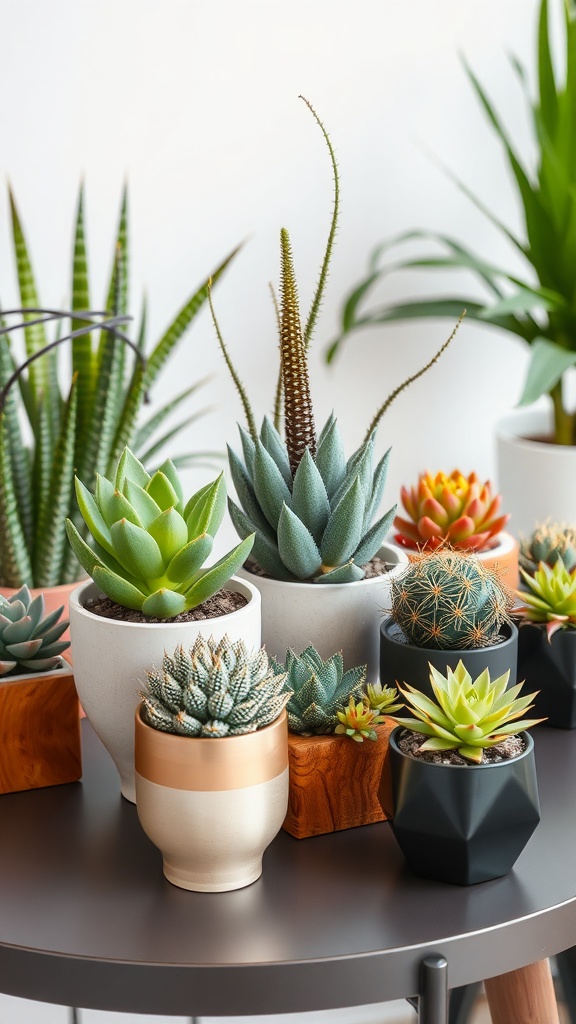
Succulents are perfect for minimalist spaces. Their unique shapes and colors add a touch of life without overwhelming the decor. In the image, you can see a variety of succulents arranged neatly on a stylish table. Each plant has its own pot, showcasing different textures and finishes.
The combination of earthy tones and modern designs creates a balanced look. The pots range from sleek black to natural wood, making it easy to mix and match. This variety allows you to personalize your space while keeping it simple.
Arranging succulents in groups can create visual interest. You can play with heights and colors to make an eye-catching display. For example, taller plants can be placed in the back, while smaller ones can sit in front. This layering effect draws the eye and adds depth.
Succulents are low-maintenance, making them ideal for busy lifestyles. They thrive in bright light and need minimal watering. This makes them a great choice for those who want greenery without the fuss. Plus, they can be easily moved around to refresh your space.
Seasonal Planting Calendar for Year-Round Growth
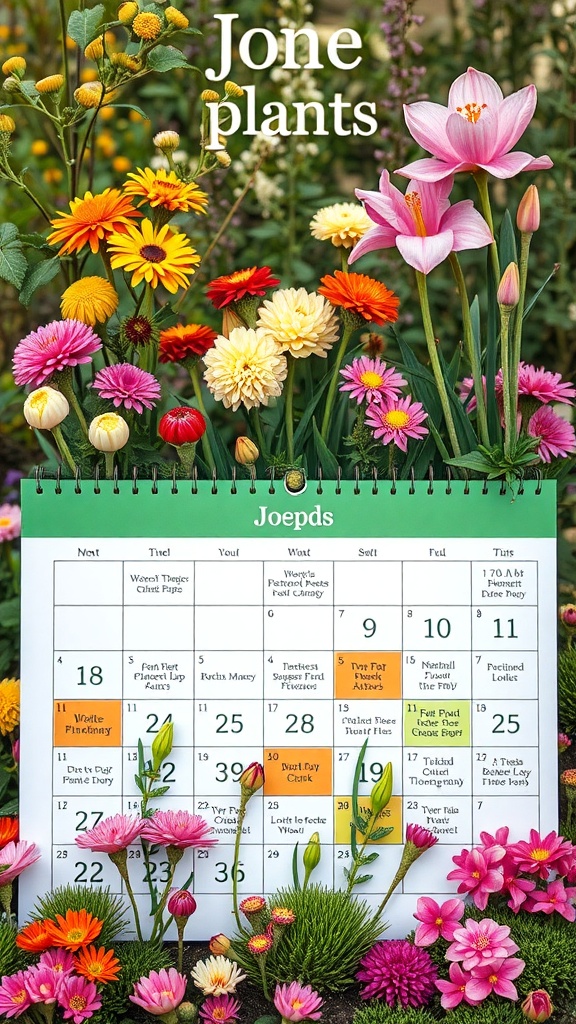
Planning your home garden can be a fun and rewarding experience. The image shows a vibrant display of flowers alongside a calendar for June planting. This calendar serves as a helpful guide for what to plant during this month.
The colorful blooms in the image highlight the beauty of seasonal plants. Each flower adds a splash of color, making any garden feel lively and inviting. The calendar lists various planting tasks, like sowing seeds and caring for existing plants, ensuring you stay on track throughout the month.
Using a seasonal planting calendar helps you maximize your garden’s potential. By knowing when to plant specific flowers and vegetables, you can enjoy a continuous bloom and harvest. This approach not only keeps your garden looking fresh but also supports local wildlife.
Whether you’re a beginner or a seasoned gardener, having a clear plan can make all the difference. So grab your tools, check your calendar, and get ready to enjoy the beauty of your garden all year long!
Natural Fencing with Hedges
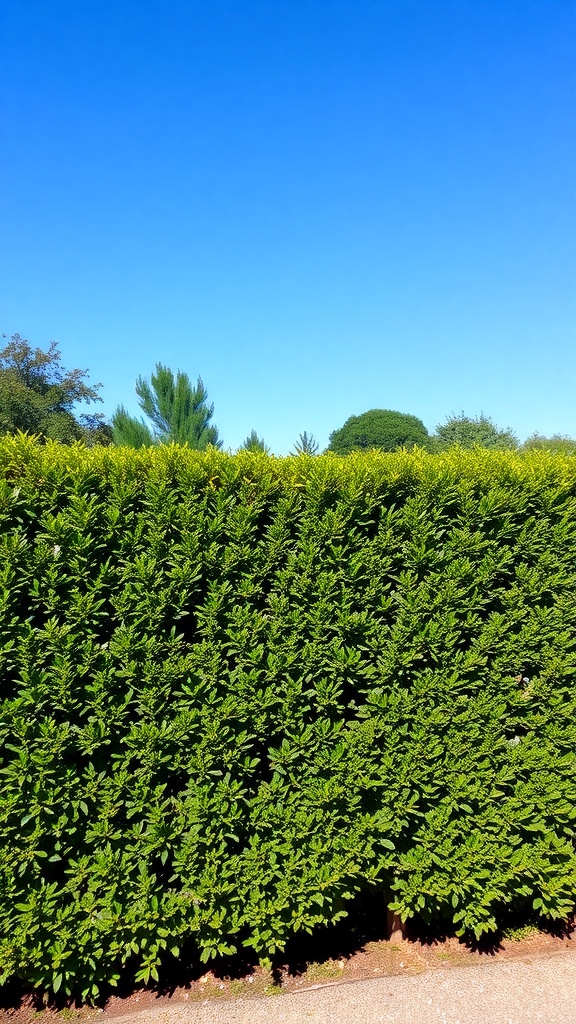
Using hedges as natural fencing is a fantastic way to define your garden space. The image shows a lush, green hedge that creates a beautiful boundary. This type of fencing not only looks great but also offers privacy and can act as a windbreak.
Hedges come in various shapes and sizes, allowing you to choose one that fits your style. They can be trimmed to maintain a neat appearance or left to grow wild for a more natural look. The vibrant green color adds life to your garden and can complement other plants beautifully.
One of the best things about hedges is that they attract wildlife. Birds and beneficial insects love to make their homes in dense foliage. This can help create a lively atmosphere in your garden.
When selecting a hedge, consider the climate and soil type in your area. Some plants thrive in certain conditions, while others may struggle. Once established, hedges require minimal maintenance, making them a practical choice for busy gardeners.
Garden Art Installations for Personal Touch
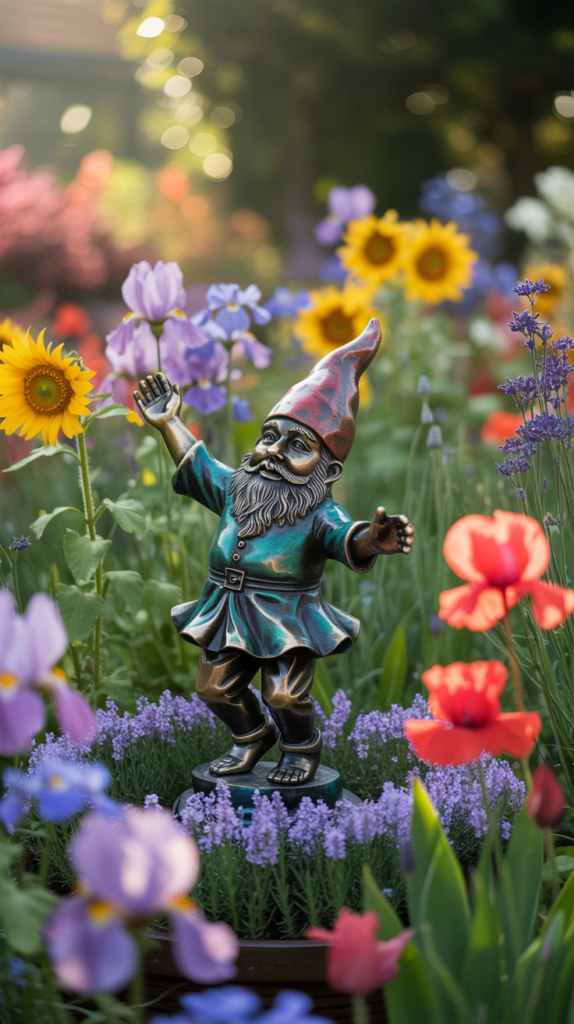
Adding art to your garden can really make it feel like home. The image shows a colorful garden with vibrant flowers and unique sculptures. This kind of installation invites curiosity and adds character to your outdoor space.
Incorporating art pieces, like the stylish vase and the whimsical lamp, can enhance the overall look. These elements break the monotony of plants and flowers, making the garden more visually appealing. You can mix different styles, from modern to rustic, to reflect your personality.
Don’t forget about the flowers! The bright pink blooms and lush greenery complement the art installations beautifully. They create a lively atmosphere that draws people in. Consider planting seasonal flowers to keep the garden fresh and inviting throughout the year.
Garden Zones for Diverse Planting
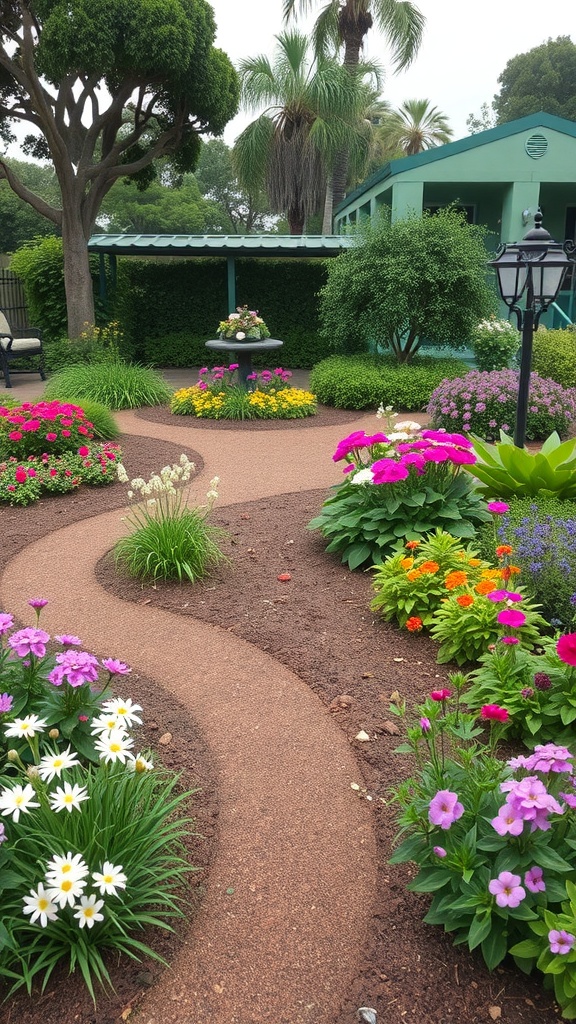
Creating a beautiful home garden involves understanding garden zones. These zones help you choose the right plants for your space. The image shows a stunning garden with a winding path surrounded by colorful flowers and lush greenery.
The vibrant blooms in shades of pink, yellow, and white create a cheerful atmosphere. This setup highlights how different plants can thrive together, making the garden visually appealing. The path invites you to explore, showcasing how thoughtful design can enhance your outdoor space.
When planning your garden, consider the sunlight and moisture levels in different areas. Some plants love full sun, while others prefer shade. Mixing plants that thrive in various conditions can lead to a lively and diverse garden.
Incorporating a variety of textures and colors, like the ones seen in the image, can make your garden feel more dynamic. Don’t hesitate to experiment with different combinations to see what works best in your garden zones.
Garden Workshops for Community Engagement
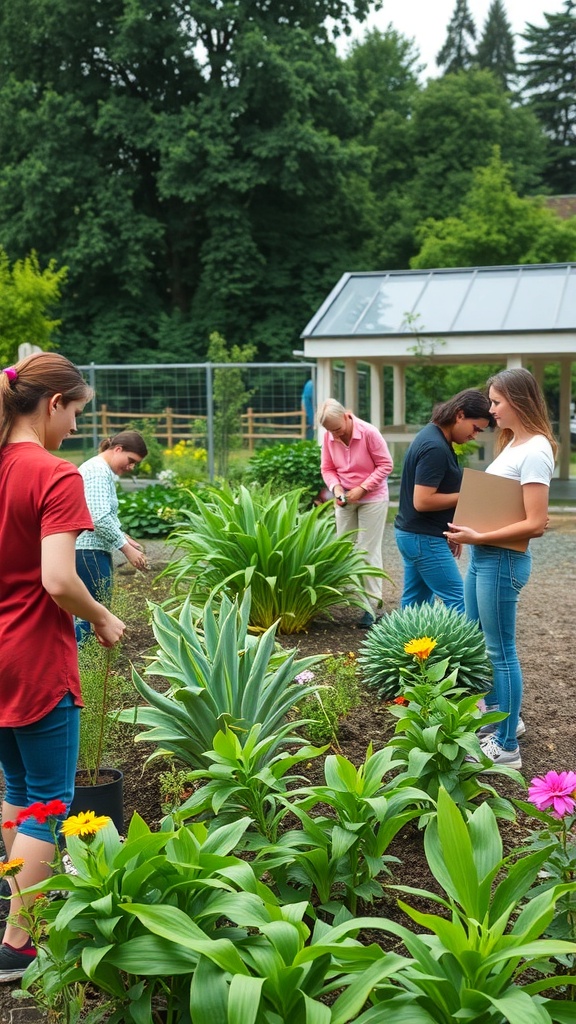
Garden workshops are a fantastic way to bring people together. In the image, you can see a group of individuals actively participating in a gardening session. They are planting flowers and tending to the greenery, showcasing teamwork and community spirit.
These workshops not only teach valuable gardening skills but also foster connections among neighbors. Participants can share tips, exchange ideas, and even form friendships while working side by side. It’s a great way to learn about plants, soil, and sustainable gardening practices.
Hosting a garden workshop can be simple. You just need a space, some tools, and a few enthusiastic participants. Whether it’s a small backyard or a community garden, the focus is on collaboration and learning. Everyone leaves with new knowledge and a sense of accomplishment.
Engaging the community through gardening can also lead to beautifying local spaces. Imagine a neighborhood filled with vibrant flowers and lush greenery, all thanks to the collective effort of its residents. It’s a win-win for everyone involved!
Rain Gardens for Stormwater Management
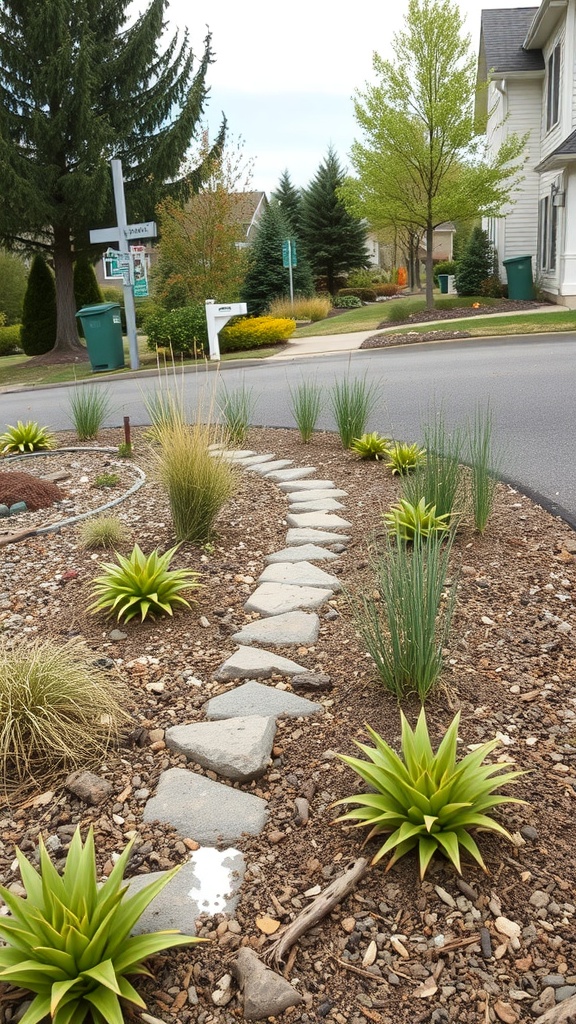
Rain gardens are a fantastic way to manage stormwater while adding beauty to your home garden. The image shows a well-designed rain garden featuring a winding stone path surrounded by various plants. This setup not only looks great but also helps absorb rainwater, reducing runoff.
The plants in the garden are chosen for their ability to thrive in wet conditions. They help filter pollutants from the water before it reaches the groundwater. This is a simple yet effective way to contribute to local water quality.
Creating a rain garden can be a fun DIY project. Start by selecting a low area in your yard where water tends to collect. Dig a shallow depression and fill it with soil that drains well. Then, choose native plants that can handle both wet and dry conditions. This way, your garden will flourish throughout the seasons.
Wildlife Habitats for Biodiversity
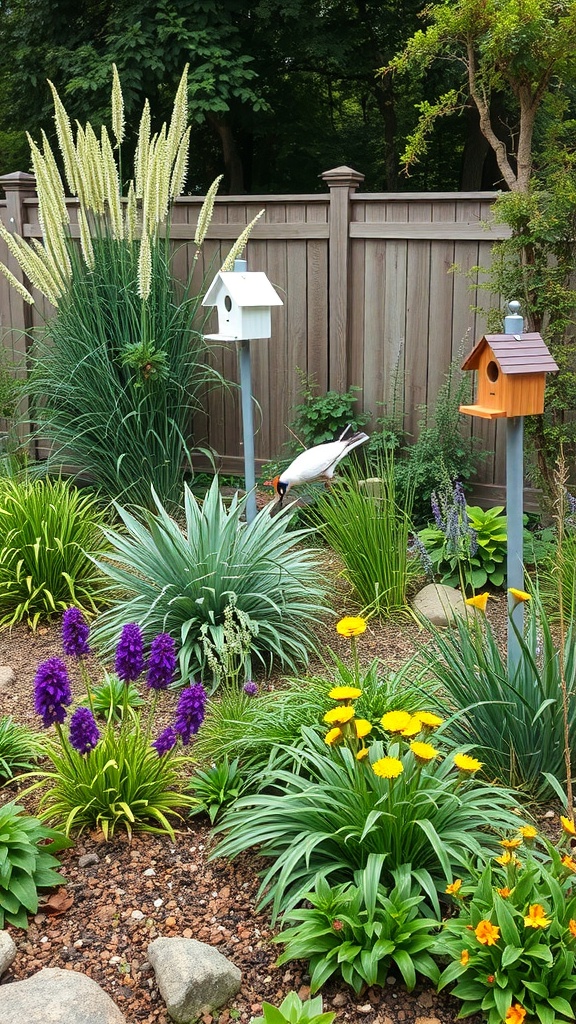
Creating a wildlife-friendly garden is a fantastic way to support local biodiversity. The image shows a vibrant garden with colorful flowers and birdhouses, making it an inviting space for various creatures.
Birdhouses are a great addition, providing safe nesting spots for birds. In the image, you can see two birdhouses, one white and one brown, which can attract different bird species. Adding these structures encourages birds to visit, bringing life and movement to your garden.
The flowers in the garden, like the purple and yellow blooms, not only add beauty but also attract pollinators such as bees and butterflies. These insects play a crucial role in pollination, helping plants thrive and produce fruits and seeds.
Incorporating native plants is another way to create a welcoming habitat. They are well-suited to the local environment and provide food and shelter for wildlife. The lush greenery in the image shows a mix of plants that can support various species.
Finally, adding rocks and other natural elements can create hiding spots for small animals, enhancing the habitat further. This garden is a perfect example of how a little effort can lead to a thriving ecosystem right at home.
Rock Gardens for Low-Maintenance Beauty
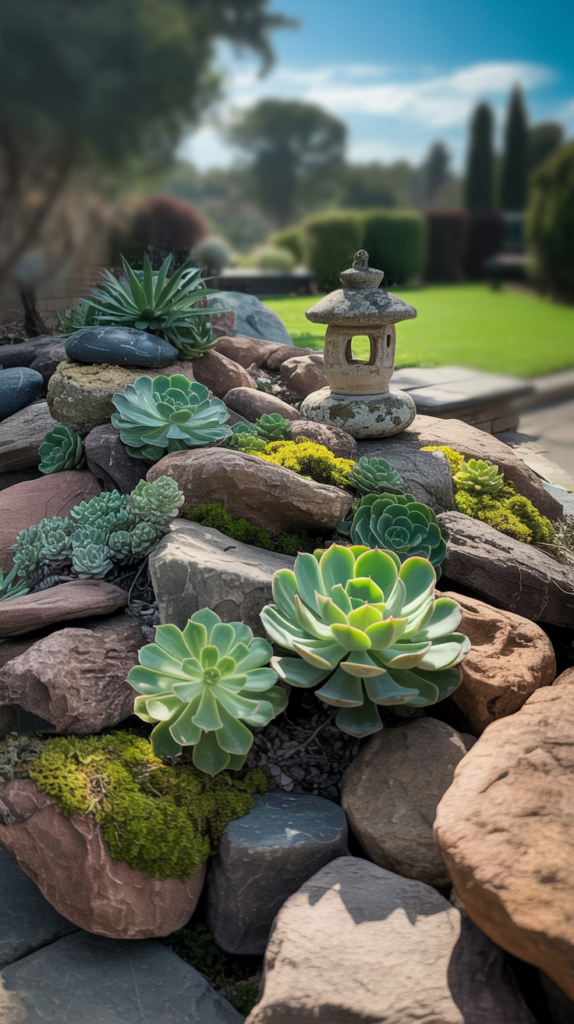
Rock gardens are a fantastic way to add charm to your outdoor space without a lot of fuss. The image showcases a beautiful arrangement of stones and succulents, creating a serene and inviting atmosphere.
The mix of smooth and textured stones provides a natural look that complements the vibrant green of the succulents. These plants are perfect for rock gardens since they require minimal water and care, making them ideal for busy gardeners.
Incorporating various sizes of rocks adds depth and interest to the garden. You can choose larger boulders as focal points and scatter smaller pebbles around to fill in gaps. This not only enhances the visual appeal but also helps with drainage.
To create your own rock garden, start by selecting a sunny spot. Arrange your stones in a way that feels natural, and then add your favorite succulents. With a little creativity, you can transform a simple area into a stunning low-maintenance retreat.
Seasonal Decor for Festive Gardens
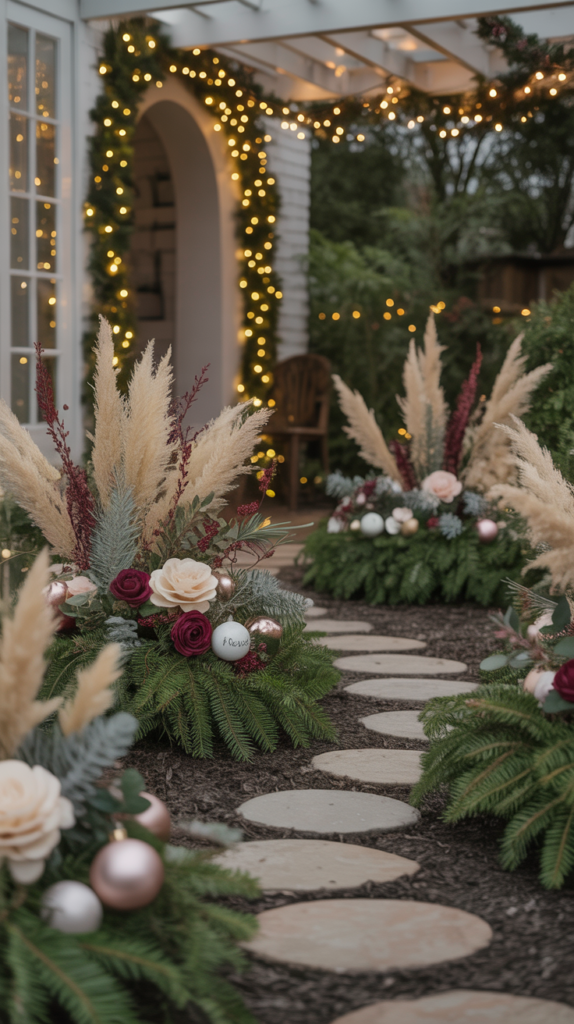
Creating a festive garden is a great way to celebrate the seasons. This image shows a charming garden pathway decorated for the holidays. The vibrant colors of the flowers and the cheerful decorations set a joyful tone.
The pathway is lined with lush greenery and colorful blooms, making it inviting. The decorations include red bows, ornaments, and playful figures, adding a whimsical touch. This festive decor not only enhances the beauty of the garden but also brings a sense of warmth and cheer.
Consider adding similar elements to your own garden. String lights, wreaths, and seasonal plants can transform your space. Embrace the spirit of the season and let your garden shine with creativity!
Outdoor Cooking Spaces for Garden Gatherings
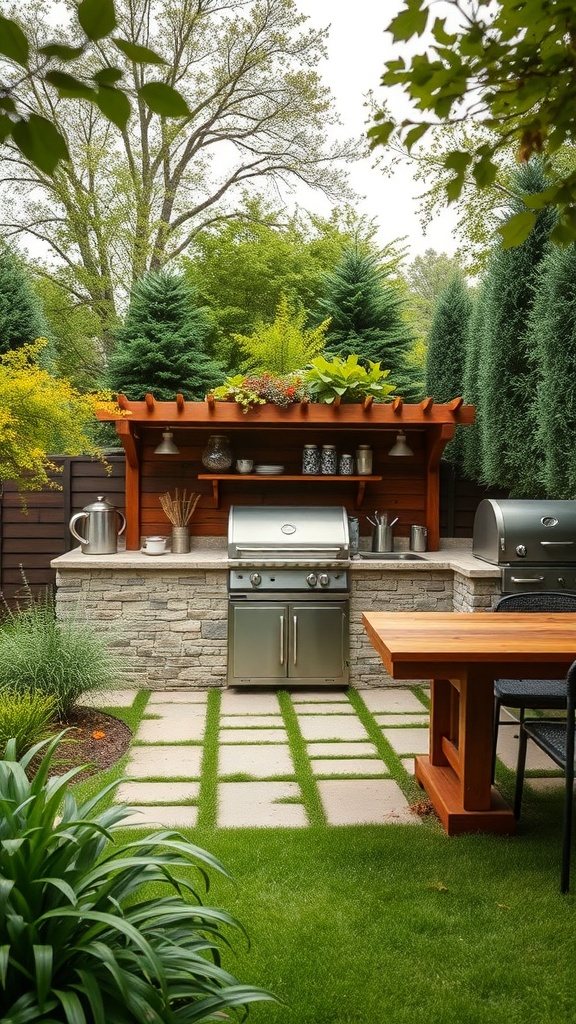
Creating an outdoor cooking space can turn your garden into a lively gathering spot. Picture a cozy area with a stylish grill and a prep station, perfect for whipping up delicious meals. This setup not only makes cooking easier but also encourages everyone to join in the fun.
The image shows a well-designed outdoor kitchen featuring a sleek grill, stone countertops, and a wooden pergola adorned with greenery. This kind of space invites friends and family to gather around, share stories, and enjoy good food together. The natural elements, like the lush grass and surrounding trees, add to the charm, making it a lovely backdrop for any gathering.
To make the most of your outdoor cooking area, think about adding a dining table nearby. This way, you can serve meals right where the action is. Incorporating comfortable seating allows everyone to relax and enjoy the atmosphere. Whether it’s a barbecue or a casual brunch, having a dedicated space for cooking and dining elevates the experience.
Consider using materials that blend with your garden’s aesthetic. Stone and wood can create a warm and inviting look. Adding some potted herbs can also enhance the cooking experience, providing fresh ingredients at your fingertips. With a little creativity, your outdoor cooking space can become the highlight of your home garden.
